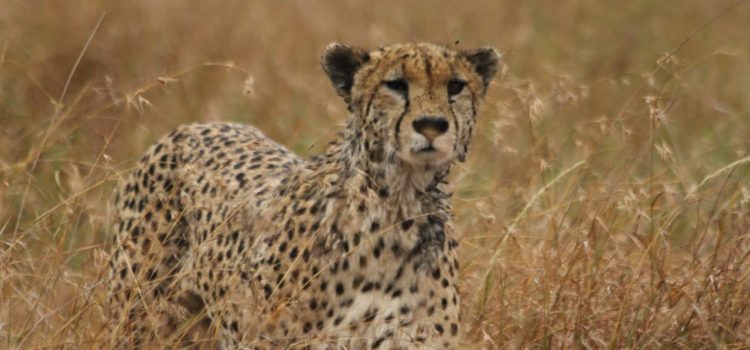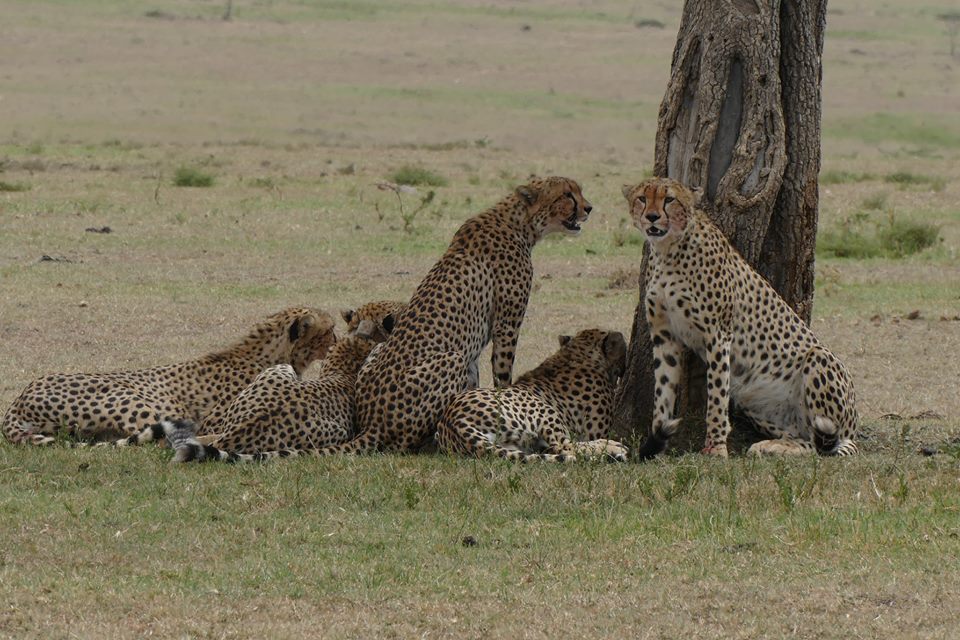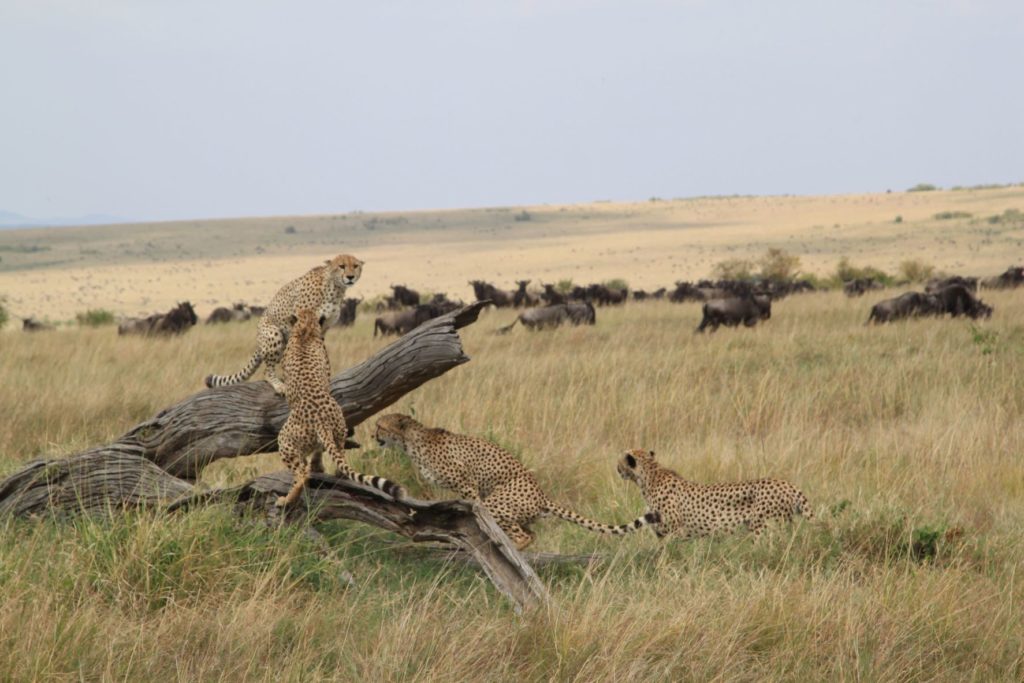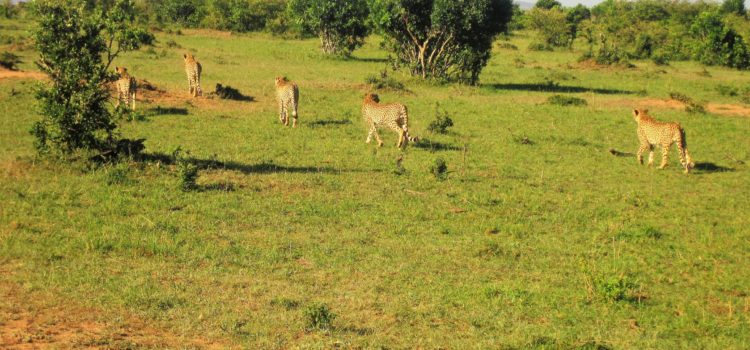Death of Olpadan, former member of Tano Bora Cheetah Coalition
UPDATE, 14th FEBRUARY 2022: On 13th February, Olarishani, a member of the Nne bora (form the original Tano Bora Cheetah coalition was discovered by guides lying down and in pain. He was seriously injured and vets were called to come and attend to him. Unfortunately, he succumbed to what appeared to be internal injuries. The four Cheetahs were crossing the Talek River heading towards the Ol Kiombo side and it is suspected that Olarishani was attacked by a Crocodile, leaving him with life threatening injuries, which led to his death.
His coalition mates, Leboo and Winda were spotted calling out for Olonyok who was not with them. On 14th February, both of them have crossed back the Talek River from the Ol Kiombo side to Tipilikwani area and they seem to be seeking to reunite with Olonyok who is still not with them.
From tano bora, to nne bora and now the coalition is only three members, the tatu bora. Nature is really taking its course on this magnificent coalition.
The morning of 26th January 2022 was a sad one for wildlife lovers; not just in Masai Mara National Reserve, but also across the world, who had come across the famous Tano Bora Cheetah Coalition while on safari in Kenya.
During the early morning game drive, Olpadan who was the former coalition leader who had since July 2021 been kicked out of the group was found dead. The lifeless and seriously injured Cheetah’s body, whose name “Olpadan” means “a sharp shooter” in Maa language was found lying on a murram track toward’ s Fig Tree Camp.
Although no one witnessed his death, his four former coalition partners were sighted near the area where Olpadan’s lifeless body was found. They looked weary, they were making calls and their bodies were bloodied. This made local guides and conservationists to believe that Olpadan had died as a result of a fierce fight with the four Cheetahs, now known as the Nne Bora (Magnificent Four”, after their ejection of Olpadan from their coalition in July 2021.
The area under which he was killed falls under the expansive territory that the Nne bora command. Olpadan had already moved out of this territory and it was not clear if he was trying to re-join the coalition or not.
The fascinating story of the Tano Bora began towards the end of 2016 when they were sighted in the Masai Mara for the first time. Never before had such a big coalition of Cheetahs been recorded. By 2017, the five boys had become a hit in Masai Mara. They had become so popular because of the ease with which they could bring down big prey like Topi and Wildebeests. Sometimes making a kill more than once in a day. This is unlike solitary or smaller coalitions that could only hunt Gazelles, hares and other smaller animals. Photos and video clips of the Tano bora were now being shared on social media and spreading across the world.
With time, the Fast Five coalition boys had become masters in the art of hunting, and could even bring down adult Zebras without much difficulty.
For about 4.5 years, Olpadan was a member of Masai Mara’s famous Tano Bora Cheetah Coalition .
During that period, he was the group leader and decision maker, instigating attacks during hunting. He always seemed dominant over the other members and could even show aggression towards them.
Some reports say that he lost one of his testicles during a fight with other males sometimes in 2019, leading to a drop in his rank……
From the group leader and lead hunter, Olpadan became the lowest ranked, the last one to enjoy the meal after a hunt.
Often, Olpadan would desert the group for some days to go and mate. He had also been seen together with other male Cheetahs he was trying to form coalitions with, one of them being Kijana. He would always rejoin the group and be part of the coalition again. The group would always accept him back, although unwillingly.
This would however turn not to be the case at the end of July 2021.
Upon rejoining the group after one of his escapades, Orpadan faced hostility from his coalition members. This led to a fierce fight that led to his right eye being seriously injured. It took the intervention of vets to treat him although they estimated that he would lose his eyesight by 35%. After this fight, the might warrior had been ejected from the group.
After the ejection, Orpadan began his solo life. Often, he was spotted in the company of new male coalition mates, although this did not last long.
Being the warrior that he was, Orpadan could still hunt alone, and he tried to keep off the Nne bora territory where the other four males roamed. It seems like the last fight that had gotten his eye injured had made him believe that his former partners meant no good for him.
Cheetahs are territorial cats and will jealously guard their territory in order to reduce competition for food and mating partners. It would seem like Olpadan had broken the territorial code and his mates, who now considered him a competitor were not ready to have none of it.
Meanwhile, the coalition of Four Cheetahs (Nne Bora) continue to traverse the Masai Mara, across their expansive territory that covers as many as 100 square kilometers. They seem as strong and fearless as they were when they were five. It will be interesting to see how this coalition behaves in the coming years and wildlife enthusiasts and researchers will be keen to note any new developments. Feel free to contact us for a Kenya Big Cats safari and we shall suggest an itinerary that suits your interests, budget and pace.
The Tano Bora- Masai Mara’s fascinating coalition of Five Cheetahs
It goes without saying that the Big Cats, (Lions, Leopards, and Cheetahs), are some of the biggest attractions that make Masai Mara one of the leading wildlife reserves in Africa, renown all over the world. Every game drive and every new visit to Masai Mara offers new sightings and a whole different game viewing experience.
Cheetahs are gentle and gracious cats. While on a game drive, they are mainly tolerant of human presence, and they love jumping over the safari jeeps in order to get a vantage point from where they can scan the plains for prey. Often, they will on a sunny day walk slowly closer and closer to the safari jeeps as you take photos or video, before finally lying under the car to protect themselves from the scorching sun.
A close encounter with Cheetahs will make you love them even more. They are skillful hunters who spend more time stalking their prey, so that they can spend less energy when making an ambush. Cheetah are the fastest mammals on land, capable of reaching speeds of up to 120km/h over short distances. The skillful cats can accelerate from 0 to 100 km/h in three seconds while on a hunting mission. While at full speed, the Cheetah can cover more than 7 meters in one stride and more than 25 meters in a second. This leaves their target prey with almost zero chance of escaping.
With a hunting success rate of about 58 %, the Cheetah is the best hunter if compared to Leopards at 38% and Lions at 30% (while hunting in pairs or a group). Although not gifted with a heavy built like Lions and Leopards, a Cheetah is intelligent enough to know when and where to hunt, where to live away from enemies, when to fight and when to walk away.
In the Masai Mara – Serengeti eco system, Cheetahs have been sighted abandoning their fresh killed prey to stay safe from Hyenas and Lions. Mother Cheetahs have however also been sighted standing up to bigger enemies like Lions who seek to kill their young ones.
A mother Cheetah protecting her cubs from a Lioness
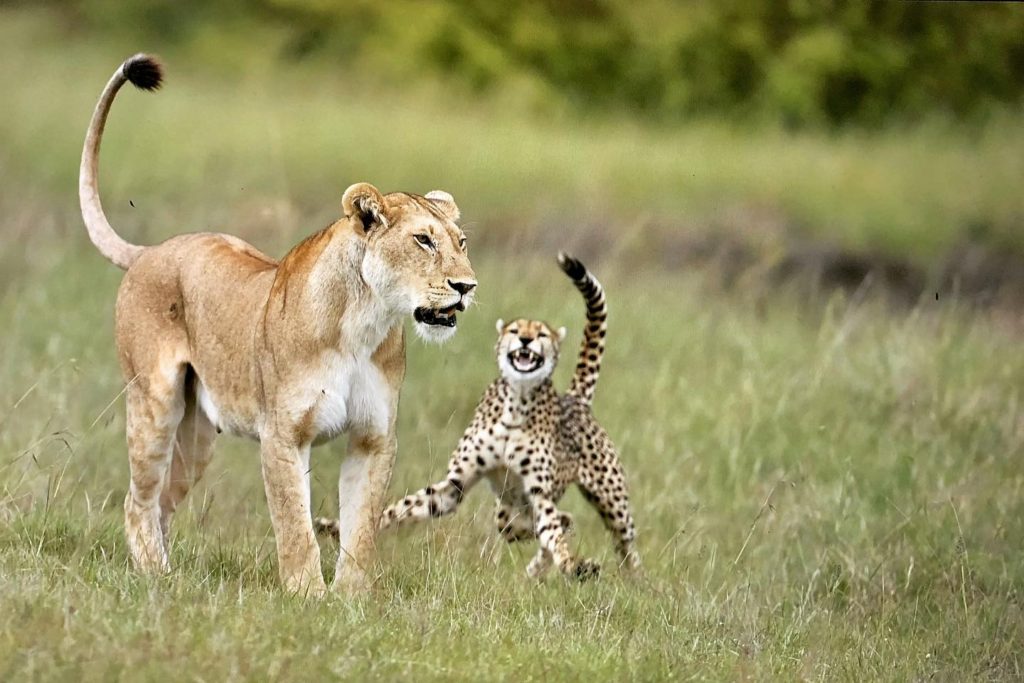
Cheetah sightings in Masai Mara had always been amazing. This was until early 2017 when a coalition of five male cheetahs emerged in the vast mottled plains. The experience became fascinating. The “Fast Five” or “Tano Bora” or “The Musketeers” as they are popularly referred to by safari guides have captured the hearts and lenses of so many Mara aficionados and turned the general perception about Cheetahs on its head.
UPDATE: OLPADAN, ONE OF THE TANO BORA COALITION MEMBERS AND FORMER LEADER OF THE GROUP WAS FOUND DEAD ON THE MORNING OF 26TH JANUARY 2022. HE HAD SERIOUS WOUNDS AROUND HIS BODY.
ALTHOUGH NO ONE WITNESSED HIS DEATH, IT IS BELIEVED THAT HIS FORMER COALITION PARTNERS WHO WERE ALSO SIGHTED IN THE AREA THE SAME MORNING HAD KILLED HIM DURING A FIERCE FIGHT. PLEASE SEE OUR STORY ON THE LINK ON THE FOLLOWING LINK:
UPDATE, 14th FEBRUARY 2022: On 13th February, Olarishani, a member of the Nne bora (form the original Tano Bora Cheetah coalition was discovered by guides lying down and in pain. He was seriously injured and vets were called to come and attend to him. Unfortunately, he succumbed to what appeared to be internal injuries. The four Cheetahs were crossing the Ol Talek River heading towards the Ol Kiombo side and it is suspected that Olarishani was attacked by a Crocodile, leaving him with life threatening injuries, which led to his death.
His coalition mates, Leboo and Winda were spotted calling out for Olonyok who was not with them. On 14th February, both of them have crossed back the Talek River from the Ol Kiombo side to Tipilikwani area and they seem to be seeking to reunite with Olonyok who is still not with them.
From tano bora, to nne bora and now the coalition is only three members, the tatu bora. Nature is really taking its course on this magnificent coalition.
The Tano Bora is not only the biggest known Cheetah coalition in the Mara, but also the first one recorded in recent years. The confidence, strength and skills that the Tano Bora exhibit during their escapades across the Mara has changed the assumptions that scientists had about Cheetah behavior.
To begin with, a coalition of 5 Cheetahs isn’t normal. Typically, a male Cheetah will upon reaching adulthood part ways with the mother to either become solitary, or join another male Cheetah to form a pair. This will help when it comes to taking down prey, and in guarding their territory.
The sighting of the 5 male cheetah coalition therefore attracted many wildlife lovers, including researchers who began to monitor this formidable coalition. Many actually thought that this would not last long.
Further follow up on these Cheetahs revealed that they are not brothers as some had assumed. Of the five musketeers, only two of them are believed to be of the same litter. No one knows about the other two, while it was also discovered that one of them is a lone ranger who is rumored to have come all the way from the Serengeti to join the group, despite having no family relations.
Oozing confidence that comes with the tyranny of numbers,
The Fast Five have turned the vast Masai Mara plains into a stomping ground for five odd years.
The marauding boys have become synonymous with thrilling hunts of prey that is bigger than themselves. During the wildebeest migration, they can take down more than one wildebeest within a day. They make killing a Topi look like a kid’s job. There is nothing as awe inspiring as catching all of the Fast Five in full-speed pursuit, or mid-kill committing their full bodyweight to bring an adult wildebeest down to the ground. In November 2020, the five were caught on camera bringing down an adult Zebra which they first had to separate from a dazzle of several others. This was the first time they were recorded on a Zebra hunt and the skills, speed and power that they exhibited made them look more like Lions than Cheetahs.
The Fast Five bringing down a Zebra
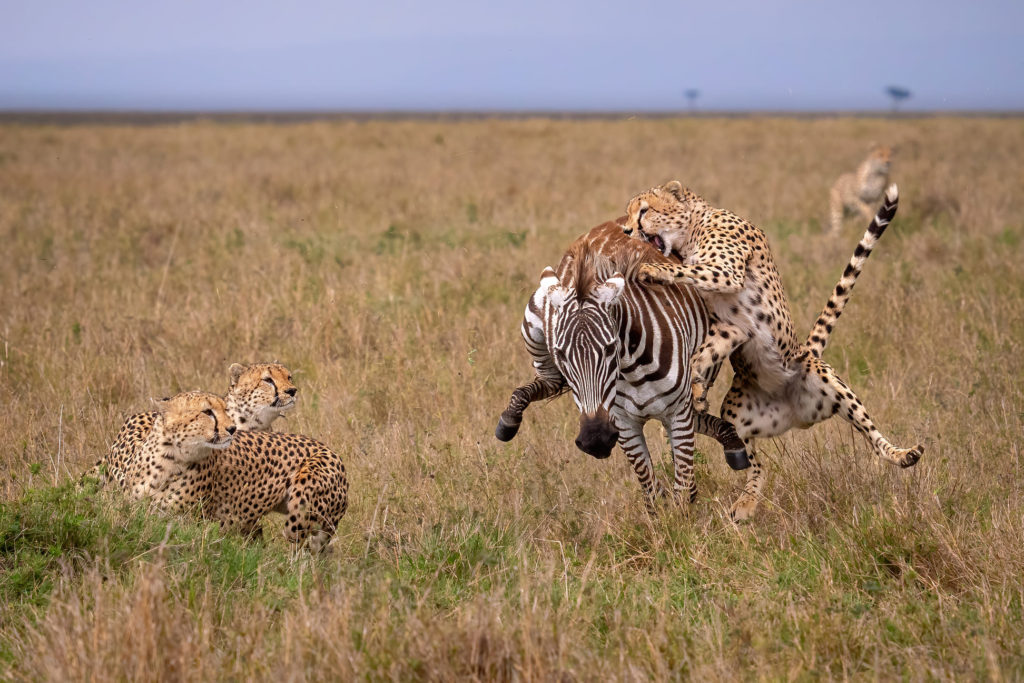
During their observation over the last 5 years in Masai Mara, researchers and guides have identified character traits that are unique to each of the five Cheetahs. This has led to each of them being given a name accordingly.
Olpadan had been identified as the coalition leader until recently. In the Maa language, his name means one with a great ability to shoot. Over the years, he has been noted to exhibit bullying tendencies. Olonyok, meaning the one who works hard to achieve better results in Maa language often the victim of Olpadan’s aggressiveness. This would often draw the attention of Olarishani, meaning the Judge in Maa language as besides being a skillful hunter, he is usually the peace maker in the coalition, often coming to the defense of any coalition mate when there are squabbles.
The fourth member is Leboo, meaning the one who always stays within a group. He is the one who is rarely spotted breaking away from the coalition, unlike the others who would occasionally desert the group for a few hours or days. The fifth member of the Fast Five coalition is Winda, meaning hunting in Kiswahili. True to his name, he is the one who mainly initiates many hunting attacks, and who displays more prowess in bringing down a prey.
Tano Bora taking down a Wildebeest
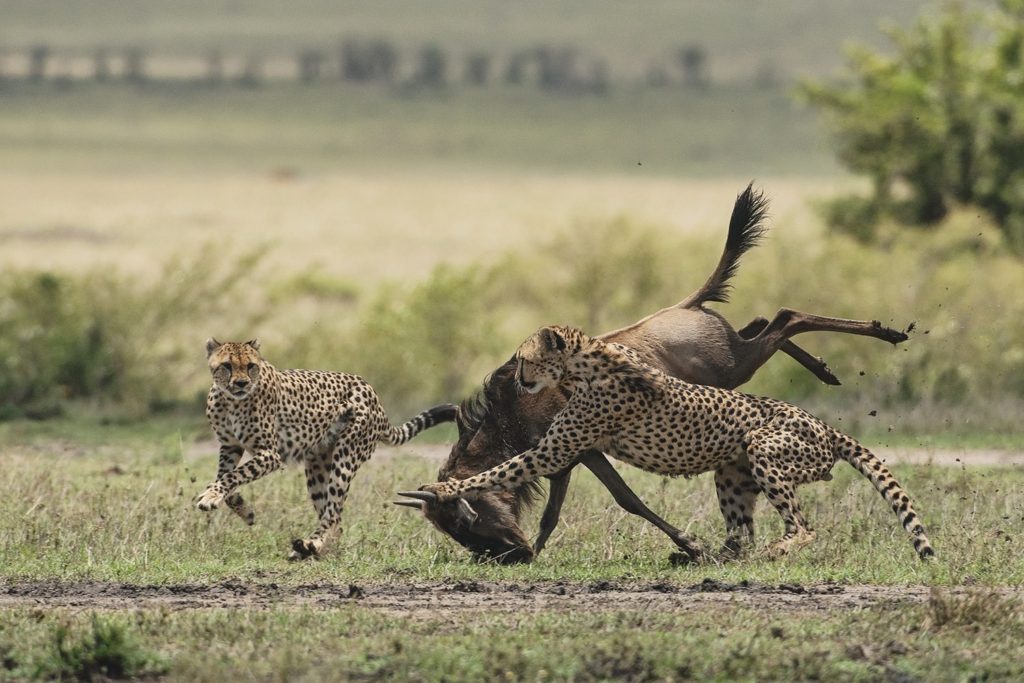
Lions are the ultimate social cats. They stay in prides that consist of Males, females, sub adults and cubs and have territories that they stay within. They will mainly hunt in pairs or in groups and have a social hierarchy, led by the dominant male. Often, they will be seen engaging in social bonding acts like licking of each other and fluffing of tails.
The same has been noted among the Tano Bora Cheetah coalition. You will see one cheetah or another periodically rousing itself, only to collapse into sleep next to another member of the coalition. This is a way of seeking physical contact with each other: an unmistakable hallmark of social bonding. They also exhibit social hierarchy under the leadership of Olpadan and Olarishani, who share the responsibilities of selecting the prey they will go for, mitigating internal conflict, and directing movement across their territory. The main advantage of Cheetahs being in a coalition is the fact that they help each other during hunting, and in protecting their territories. Throughout the Mara- Serengeti eco system, lone or pairs of Cheetahs have been seen to prefer going after Thomson Gazelles which are small in size, and sometimes warthogs and hares. But in big coalitions like the Tano Bora, they will often take down Wildebeests and even Zebras. While solitary Cheetahs and coalitions of two or three male Cheetahs are known to roam within a small territory, the Fast Five enjoy a big territorial range. They have been sighted far away from their main territory within the Tipilikwani area, going as far as past Keekorok and even crossing over the Talek River to spend some days at the Olare Motorogi Conservancy, outside the main reserve.
Wildlife enthusiasts hope that this coalition remains together long enough for more thrilling moments by photographers and for researchers to learn more about them, and Cheetah coalitions in general.
You are welcome to contact us for an expertly crafted and privately guided safari while enjoying a front row seat to encounter the Big Cats of Kenya and Tanzania. Contact us on: holidays@esseniasafaris.co.ke
Mobile and whats app: +254 723 77 57 49
Skype: Sam.Waweru3

